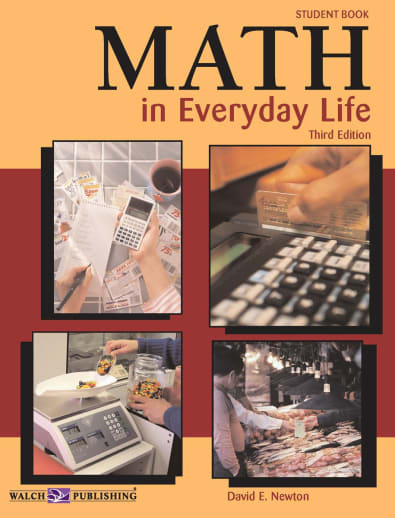Math in Everyday Life
Description
Included in this new edition are
• Up-to-date forms, prices, and salaries
• Internet and calculator activities
• Lessons involving on-line shopping, electronic banking, IRAs, new tax information, and more
In this consumer math workbook, the student helps different members of the fictional Van Dusen family with their financial affairs. This shows the student how he or she can expect to use math in everyday life. Exercises cover practical math topics such as income, budgets, checking and savings accounts, mortgage loans, utility bills, car expenses, life insurance, and income taxes. All exercises use up-to-date (to 2001) forms and tax information. Internet activities, such as researching college expenses or finding on-line interest calculators, are suggested in each chapter.
The focus of this workbook is not on providing algorithms, but on presenting realistic financial situations. It is not meant to be a textbook. The student is encouraged to develop his or her own algorithms. Basic problem solving skills, as well as the ability to calculate percentages, price per unit, and area is assumed. Although the math used in this workbook is fairly simple, the exercises may be difficult for the student because of unfamiliar financial terms or inexperience with gathering data from tables and records. For this reason, the teacher may want to discuss terms and approaches to problems rather than having the student work through the book.
Discussion suggestions, comments on internet activities, and exercise solutions are provided in the Teacher's Guide. The Teacher's Guide is extremely helpful because it supplies the answers to exercise questions, such as the difference between simple and compound interest or the definition of property-damage liability. This workbook is intended for 6-8th grade students, but any high-schooler who has not yet covered consumer math could benefit from it. ~ Anh
| Product Format: | Softcover Book |
|---|---|
| Grades: | 5-12 |
| Brand: | Walch Education |
| Author: | David Newton |
| ISBN: | 9780825142581 |
| EAN/UPC: | 700507016800 |
| Length in Inches: | 10.75 |
| Width in Inches: | 8.5 |
| Height in Inches: | 0.5 |
| Weight in Pounds: | 1.15 |
| Edition: | Activity Book |
| Pages: | 214 |
| Publication Date: | 10/1/2013 |

